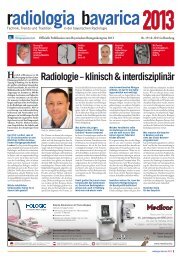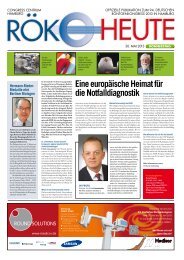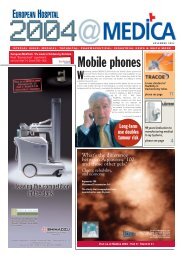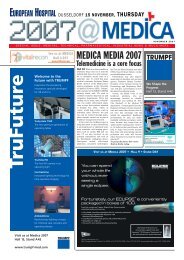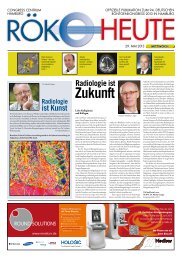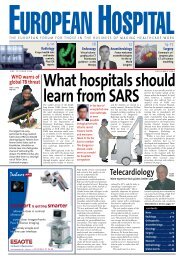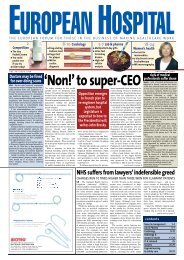PET scanning the heart cuts costs - European-Hospital
PET scanning the heart cuts costs - European-Hospital
PET scanning the heart cuts costs - European-Hospital
Create successful ePaper yourself
Turn your PDF publications into a flip-book with our unique Google optimized e-Paper software.
‘<br />
MANAGEMENT<br />
Market-oriented performance measurement<br />
The impact of deregulation and internationalisation<br />
on <strong>the</strong> structures of healthcare systems have made marketoriented<br />
performance management and controlling a central<br />
challenge for today’s hospital managers. Professor Rainer<br />
Sibbel, Chairman of <strong>the</strong> Institute of International Health<br />
Management and Director of its MBA - International<br />
<strong>Hospital</strong> Management Programme for healthcare<br />
professionals, at <strong>the</strong> HfB Business school of Finance and<br />
Management,Frankfurt, describes <strong>the</strong> status quo, advises on<br />
a transfer of traditional accounting methods and approaches,<br />
and adaptation to alternative approaches<br />
The main emphasis in<br />
hospitals is on costaccounting<br />
and controlling,<br />
which are traditionally<br />
attached to profit quantities that<br />
are easy to collect and to measure.<br />
The internal, cost-dominated<br />
perspective leads to a mainly<br />
operational analysis, relating only<br />
to profit and cost figures. Marketoriented<br />
performance<br />
measurement and controlling<br />
concentrates on <strong>the</strong> long view and<br />
on <strong>the</strong> hard as well as soft profitfactors.<br />
The aim is a marketrelated<br />
positioning and navigation<br />
of <strong>the</strong> hospital, to avoid market<br />
and cost problems and to secure<br />
success on <strong>the</strong> long run.<br />
Therefore, <strong>the</strong> following<br />
essential range of duties can be<br />
derived: The changed conditions<br />
require a consequent strategic<br />
planning and controlling. It helps<br />
to secure <strong>the</strong> success potentials for<br />
<strong>the</strong> future. Fur<strong>the</strong>rmore a service<br />
delivery programme must be<br />
planned actively and systematic<br />
revenue management and output<br />
controlling should be carried out.<br />
Process efficiency should be<br />
constantly questioned and<br />
improved. In such interactive and<br />
individual services, as offered in<br />
hospitals, process management<br />
and <strong>the</strong> organisation design are<br />
closely associated with capacity<br />
utilisation problems. Not to forget<br />
that quality and efficiency are<br />
decisively influenced by <strong>the</strong> staff<br />
motivation and behaviour and<br />
<strong>the</strong>refore by <strong>the</strong> incentive<br />
structures.<br />
A high number of deficits can be<br />
recognised in <strong>the</strong> status quo.<br />
Predominantly, <strong>the</strong>y often only<br />
react to changes in market and<br />
economic conditions. Mostly, only<br />
first symptoms of strategic<br />
planning, navigation and control<br />
are observable. They focus on<br />
documentation, reporting and<br />
simple variance comparison.<br />
Rough cost-object and costcentred<br />
accounting can be found,<br />
besides <strong>the</strong> domination of full and<br />
actual costing. To fulfil <strong>the</strong> needs<br />
of market-oriented performance<br />
management and controlling,<br />
active strategic planning and<br />
navigation is necessary, just as<br />
ongoing planning and control of<br />
<strong>the</strong> service programme, market<br />
and customer oriented success<br />
analysis, process-oriented<br />
calculation and structures,<br />
intensive examination of <strong>the</strong><br />
economic profitability as well as<br />
according organisational changes<br />
such as profit-centre-concepts,<br />
attempts of benchmarking and lots<br />
more. The basic maxims behind<br />
<strong>the</strong>se are improved and long-term<br />
profitability.<br />
The Balanced Scorecard (BS)<br />
developed by Kaplan and Norton,<br />
which was broadly and rapidly<br />
GE Healthcare<br />
Ultrasound<br />
Solve problems<br />
before <strong>the</strong>y<br />
become problems.<br />
It’s a lot easier to change <strong>the</strong> future when<br />
you can see it. Our understanding of<br />
disease at <strong>the</strong> molecular level will help<br />
you to diagnose disease sooner – even<br />
before symptoms appear – and prevent<br />
it from ever affecting your patients. It’s<br />
just one of <strong>the</strong> many ways advanced<br />
GE technologies enhance your ability<br />
to predict, diagnose, inform and<br />
treat. And change after-<strong>the</strong>-fact<br />
<strong>the</strong>rapy to before-onset care.<br />
No problem.<br />
Visit www.gehealthcare.com<br />
for more details.<br />
Predict<br />
Diagnose<br />
Inform<br />
Treat<br />
accepted in industry, could<br />
strongly contribute to marketoriented<br />
performance<br />
management, by means of an<br />
integrative approach. The<br />
essential advantage is that it<br />
measures financial or outputrelated<br />
success factors, and<br />
also, according to <strong>the</strong> causeand-effect-relationship,<br />
systematically considers resource<br />
and process related impacts<br />
as drivers and early<br />
GE imagination at work<br />
© 2005 General Electric Company<br />
GE Medical Systems, a General Electric company, going to market as GE Healthcare.<br />
indicators. So <strong>the</strong> BS combines <strong>the</strong><br />
external market-based view and an<br />
internal resource-based view.<br />
Fur<strong>the</strong>r on, this concept not only<br />
claims to be a complex ratio<br />
system, it should be seen as a<br />
complete management system that<br />
helps to transfer a vision into<br />
strategy and concrete actions.<br />
The essential advantages for<br />
hospitals are that <strong>the</strong> basic design<br />
of <strong>the</strong> BS is flexible enough to<br />
appropriately consider specific<br />
peculiarities in market conditions<br />
and hospital service delivery. On<br />
<strong>the</strong> one hand <strong>the</strong> BS offers <strong>the</strong><br />
opportunity and impulse to derive<br />
and implement a market-oriented<br />
strategy and to navigate its<br />
implementation. Typically,<br />
hospitals’ economic as well as<br />
material goals can be combined in<br />
continued on page 8<br />
EUROPEAN HOSPITAL Vol 14 Issue 2/05 7



